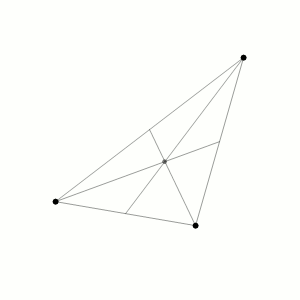|
Lars Edvard Phragmén
Lars Edvard Phragmén (2 September 1863 Örebro – 13 March 1937) was a Swedish mathematician. The son of a college professor, he studied at Uppsala then Stockholm, graduating from Uppsala in 1889. He became professor at Stockholm in 1892, after Sofia Kovalevskaia. He left Uppsala less than a year after, becoming professor Mittag-Leffler's assistant at Stockholm. In 1884, he provided a new proof of the Cantor-Bendixson theorem. His work focused on elliptic functions and complex analysis. His most famous result is the extension of Liouville's theorem to analytic functions on a sector. A first version was proposed by Phragmén, then improved by the Finnish mathematician Ernst Lindelöf. They jointly published this last version,« ''Sur une extension d'un principe classique de l'analyse et sur quelques propriétés des fonctions monogènes dans le voisinage d'un point singulier'' », Acta Math. 31, 1908 known as the Phragmén–Lindelöf principle. He left the university in ... [...More Info...] [...Related Items...] OR: [Wikipedia] [Google] [Baidu] |
Örebro
Örebro ( , ) is the List of urban areas in Sweden by population, sixth-largest city in Sweden, the seat of Örebro Municipality, and capital of the Örebro County. It is situated by the Närke Plain, near the lake Hjälmaren, a few kilometers inland along the small river Svartån, Närke, Svartån, and has a population of approximately 126,000 in the city proper. It is one of the largest inland hubs of the country, and a major Logistics, logistic and commercial operating site. Örebro is home to Örebro University, a Örebro University Hospital, major university hospital, a Örebro Castle, medieval castle, the water park Gustavsvik as well as several large shopping malls and the Oset-Rynningeviken nature reserve at the lakefront. Örebro is served by Örebro Airport 10 km (6 mi) southwest of the city, and by Örebro Central Station, serviced by the Mälaren Line and Western Main Line. Etymology The name ''Örebro'' refers to a bridge (') crossing the river Svartån, Närke, S ... [...More Info...] [...Related Items...] OR: [Wikipedia] [Google] [Baidu] |
Acta Mathematica
''Acta Mathematica'' is a peer-reviewed open-access scientific journal covering research in all fields of mathematics. According to Cédric Villani, this journal is "considered by many to be the most prestigious of all mathematical research journals".. According to the ''Journal Citation Reports'', the journal has a 2020 impact factor of 4.273, ranking it 5th out of 330 journals in the category "Mathematics". Publication history The journal was established by Gösta Mittag-Leffler in 1882 and is published by Institut Mittag-Leffler, a research institute for mathematics belonging to the Royal Swedish Academy of Sciences. The journal was printed and distributed by Springer from 2006 to 2016. Since 2017, Acta Mathematica has been published electronically and in print by International Press. Its electronic version is open access without publishing fees. Poincaré episode The journal's "most famous episode" (according to Villani) concerns Henri Poincaré, who won a prize offered ... [...More Info...] [...Related Items...] OR: [Wikipedia] [Google] [Baidu] |
Members Of The Royal Swedish Academy Of Sciences
Member may refer to: * Military jury, referred to as "Members" in military jargon * Element (mathematics), an object that belongs to a mathematical set * In object-oriented programming, a member of a class ** Field (computer science), entries in a database ** Member variable, a variable that is associated with a specific object * Limb (anatomy), an appendage of the human or animal body ** Euphemism for penis * Structural component of a truss, connected by nodes * User (computing), a person making use of a computing service, especially on the Internet * Member (geology), a component of a geological formation * Member of parliament * The Members, a British punk rock band * Meronymy, a semantic relationship in linguistics * Church membership, belonging to a local Christian congregation, a Christian denomination and the universal Church * Member, a participant in a club or learned society A learned society (; also learned academy, scholarly society, or academic association) is an ... [...More Info...] [...Related Items...] OR: [Wikipedia] [Google] [Baidu] |
Academic Staff Of Stockholm University
An academy (Attic Greek: Ἀκαδήμεια; Koine Greek Ἀκαδημία) is an institution of secondary or tertiary higher learning (and generally also research or honorary membership). The name traces back to Plato's school of philosophy, founded approximately 385 BC at Akademia, a sanctuary of Athena, the goddess of wisdom and skill, north of Athens, Greece. Etymology The word comes from the ''Academy'' in ancient Greece, which derives from the Athenian hero, ''Akademos''. Outside the city walls of Athens, the gymnasium was made famous by Plato as a center of learning. The sacred space, dedicated to the goddess of wisdom, Athena, had formerly been an olive grove, hence the expression "the groves of Academe". In these gardens, the philosopher Plato conversed with followers. Plato developed his sessions into a method of teaching philosophy and in 387 BC, established what is known today as the Old Academy. By extension, ''academia'' has come to mean the accumulation, de ... [...More Info...] [...Related Items...] OR: [Wikipedia] [Google] [Baidu] |
Swedish Mathematicians
Swedish or ' may refer to: Anything from or related to Sweden, a country in Northern Europe. Or, specifically: * Swedish language, a North Germanic language spoken primarily in Sweden and Finland ** Swedish alphabet, the official alphabet used by the Swedish language * Swedish people or Swedes, persons with a Swedish ancestral or ethnic identity ** A national or citizen of Sweden, see demographics of Sweden ** Culture of Sweden * Swedish cuisine See also * * Swedish Church (other) * Swedish Institute (other) * Swedish invasion (other) * Swedish Open (other) Swedish Open is a tennis tournament. Swedish Open may also refer to: *Swedish Open (badminton) * Swedish Open (table tennis) *Swedish Open (squash) *Swedish Open (darts) The Swedish Open is a darts tournament established in 1969, held in Malm� ... {{disambig Language and nationality disambiguation pages ... [...More Info...] [...Related Items...] OR: [Wikipedia] [Google] [Baidu] |
Phragmen's Voting Rules
Phragmén's voting rules are multiwinner voting methods that guarantee proportional representation. They were published by Lars Edvard Phragmén in French and Swedish between 1893 and 1899, and translated to English by Svante Janson in 2016. There are two kinds of Phragmén rules: rules using approval ballots (that is, multiwinner approval voting), and rules using ranked ballots (that is, multiwinner ranked voting). Background In multiwinner approval voting, each voter can vote for one or more candidates, and the goal is to select a fixed number ''k'' of winners (where ''k'' may be, for example, the number of parliament members). The question is how to determine the set of winners? The simplest method is '' multiple non-transferable vote'', in which the ''k'' candidates with the largest number of approvals are elected. But this method tends to select ''k'' candidates of the largest party, leaving the smaller parties with no representation at all. In the 19th century, there was m ... [...More Info...] [...Related Items...] OR: [Wikipedia] [Google] [Baidu] |
Phragmen–Brouwer Theorem
In topology, the Phragmén–Brouwer theorem, introduced by Lars Edvard Phragmén and Luitzen Egbertus Jan Brouwer, states that if ''X'' is a normal connected Connected may refer to: Film and television * ''Connected'' (2008 film), a Hong Kong remake of the American movie ''Cellular'' * '' Connected: An Autoblogography About Love, Death & Technology'', a 2011 documentary film * ''Connected'' (2015 TV ... locally connected topological space, then the following two properties are equivalent: *If ''A'' and ''B'' are disjoint closed subsets whose union separates ''X'', then either ''A'' or ''B'' separates ''X''. *''X'' is unicoherent, meaning that if ''X'' is the union of two closed connected subsets, then their intersection is connected or empty. The theorem remains true with the weaker condition that ''A'' and ''B'' be separated. References * * * * García-Maynez, A. and Illanes, A. ‘A survey of multicoherence’, An. Inst. Autonoma Mexico 29 (1989) 17–67. * * Wilder, R ... [...More Info...] [...Related Items...] OR: [Wikipedia] [Google] [Baidu] |
Chaos Theory
Chaos theory is an interdisciplinary area of scientific study and branch of mathematics focused on underlying patterns and deterministic laws of dynamical systems that are highly sensitive to initial conditions, and were once thought to have completely random states of disorder and irregularities. Chaos theory states that within the apparent randomness of chaotic complex systems, there are underlying patterns, interconnection, constant feedback loops, repetition, self-similarity, fractals, and self-organization. The butterfly effect, an underlying principle of chaos, describes how a small change in one state of a deterministic nonlinear system can result in large differences in a later state (meaning that there is sensitive dependence on initial conditions). A metaphor for this behavior is that a butterfly flapping its wings in Brazil can cause a tornado in Texas. Small differences in initial conditions, such as those due to errors in measurements or due to rounding errors i ... [...More Info...] [...Related Items...] OR: [Wikipedia] [Google] [Baidu] |
Three-body Problem
In physics and classical mechanics, the three-body problem is the problem of taking the initial positions and velocities (or momenta) of three point masses and solving for their subsequent motion according to Newton's laws of motion and Newton's law of universal gravitation. The three-body problem is a special case of the n-body problem, -body problem. Unlike two-body problems, no general closed-form solution exists, as the resulting dynamical system is chaos theory, chaotic for most initial conditions, and numerical methods are generally required. Historically, the first specific three-body problem to receive extended study was the one involving the Moon, Earth, and the Sun. In an extended modern sense, a three-body problem is any problem in classical mechanics Classical mechanics is a physical theory describing the motion of macroscopic objects, from projectiles to parts of machinery, and astronomical objects, such as spacecraft, planets, stars, and galaxies. For o ... [...More Info...] [...Related Items...] OR: [Wikipedia] [Google] [Baidu] |
Henri Poincaré
Jules Henri Poincaré ( S: stress final syllable ; 29 April 1854 – 17 July 1912) was a French mathematician, theoretical physicist, engineer, and philosopher of science. He is often described as a polymath, and in mathematics as "The Last Universalist", since he excelled in all fields of the discipline as it existed during his lifetime. As a mathematician and physicist, he made many original fundamental contributions to pure and applied mathematics, mathematical physics, and celestial mechanics. In his research on the three-body problem, Poincaré became the first person to discover a chaotic deterministic system which laid the foundations of modern chaos theory. He is also considered to be one of the founders of the field of topology. Poincaré made clear the importance of paying attention to the invariance of laws of physics under different transformations, and was the first to present the Lorentz transformations in their modern symmetrical form. Poincaré discove ... [...More Info...] [...Related Items...] OR: [Wikipedia] [Google] [Baidu] |
Phragmén–Lindelöf Principle
In complex analysis, the Phragmén–Lindelöf principle (or method), first formulated by Lars Edvard Phragmén (1863–1937) and Ernst Leonard Lindelöf (1870–1946) in 1908, is a technique which employs an auxiliary, parameterized function to prove the boundedness of a holomorphic function f (i.e, , f(z), Background In the theory of complex functions, it is known that the modulus (absolute value) of a |



